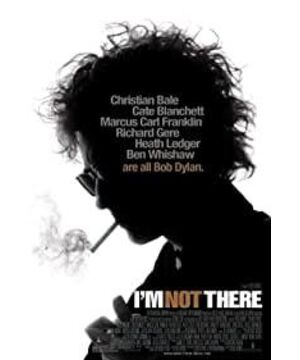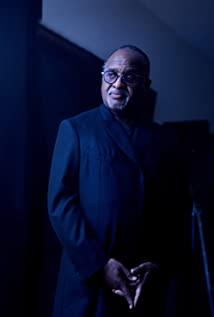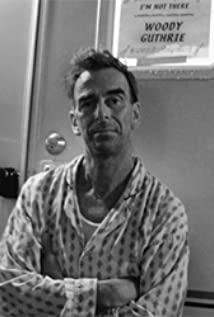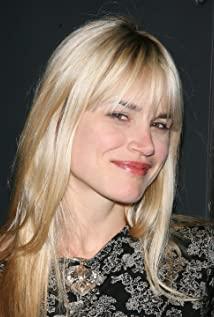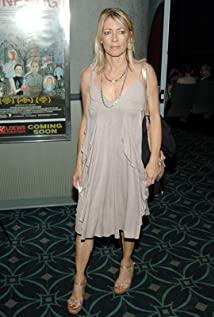person was still alive, so he made a unique biopic, and I was afraid that the interpretation would not be enough, so I asked 6 actors to interpret the person’s different life stages to show his richness. His life history, unique inner world and soul temperament, I am afraid this special treatment is none other than Bob Dylan.
As early as 2003, I tried to make a special topic for Uncle Bob's life footprints, but the big boss from Hong Kong rejected him on the grounds that "the young people today still care about Bob Dylan". However, It has always been my unfulfilled wish to be a Cover for Dylan, an old man who possesses arbitrary philosophy, mysterious artistic temperament and the most contemporary avant-garde spirit, so when I watched the movie "I'm Not There" (I'm Not There) , I feel a little bit upset.
Unlike other biopics, people who don’t know his life can also learn about it through the biographical film. "I'm Not There" seems to be filmed for Bob fans or at least people who know Bob’s life. At the same time, in view of this film The shooting method is novel, especially in terms of the imaging technology and the artistry of the film. In addition, the six-person test has different shapes, and there are differences in gender and age. The length of the film is not short, and it is easy for audiences who don’t know Uncle Bao to show it. Dizzy, not only may be uninterested, but also may become more confused as you watch it, so it is recommended that people who are tight on time and have no interest in Dylan can not watch it. This is also the destiny of this film with frequent creative ideas in structure and shooting techniques. The movie-watching price to be paid.
The film uses a method similar to the abstract of the characters and events to connect the life of Uncle Bao in chronological order. The screenwriter and director Todd Hines has always been good at "breaking his own way" (using his Carpenter biographical short "Superstar" as an example. For example), in the seventh work of his director this time, he broke up the life of the godfather-level rock master and then organically connected, interpreting and analyzing Bob’s mentality in 6 deductive ways The process and the spiritual core are subjective and speculative, and more rationalized inferences. The original title of the film "I'm Not There, A Movie About Dylan's Many Conjectures" seems to be more illustrative of why this unique creation was adopted. Technique. Hines once said: "Over the years, Bob Dylan has never rejected the role he played in the past. He keeps moving forward and constantly denying himself. My idea is to use different actors to play the same person, using differences to explain This person who is always on the road.” And what Hines said in an interview with Entertainment Weekly seemed to explain his creative concept better-“The movie draws material from his life, and 6 Bob Dylan will Stand together and tell us who exactly is Bob Dylan." And what is Bob in reality? He may be everyone, or no one!
In the beginning, Bob Dylan was set as Woody (played by Marcos Carl Franklin), the little black boy who lived in the 1950s. This is the only black and minor among the six people, representing During Bob’s childhood, and the name Woody was very meaningful, it pays tribute to Bob Dylan, the originator of American folk songs, Woody Gus, and Dylan is the inheritor of Gus’s spirit. . The little Woody in the film has personality and ideals. Although he is a child, he has a mouthful of countries and times. He wants to be another Woody Gus, wandering around with a guitar that is almost the same height as his own, and humming. The folk songs of the 1930s. And Dylan’s music is indeed deeply influenced by black rhythm and blues, and he regards Woody Guss as an idol (for details, please refer to my friend Yuan Yue (this person is also called Tu Motuo, Liao Fumei), "Rebellion from the Folk — -American Folk Song Legends), the role played by a small black actor and named after Woody is obvious-representing the two origins of Bob Dylan's music. The words "This Machine Kills Fascists" on Woody's guitar in the film came from the famous guitar of Woody Gus.
Soon, Bob became a rebellious young Arthur (played by Ben Wechau) who was obsessed with the 19th-century French poet Rimbaud. This film is presented in the form of a court trial, borrowing Rimbaud’s escape to Paris and was regarded as a wandering The experience of being locked up as a teenager hints at Rimbaud's stimulating effect on Bob's poetic aspect. It is undeniable that the lyrics written by Uncle Bao are very literary, very similar to poetry, and poetry has a great influence on him-the surname he gave himself comes from the name of the poet Dylan Thomas, once asked by a gas poet Uncle Bao: "Is there a poet who inspired you?" Uncle Bao replied: "There are only two people, Emily Dickinson and Rimbaud."
Then, the famous folk singer Jack (played by Christian Bell) appeared. And with a song "The Times They A-Changin" set off a wave of avant-garde music. And the female singer Alice, played by Julianne Moore, makes people guess that her model is Joan Bates. , And finally go their own way). This film adopts the form of character visits and replays of the performances, telling how the once passionate young Jack has transformed from a civil rights musician to a modest and peaceful religious convert with the passage of time and polishing. Alluding to Uncle Bao's later attachment to Christianity and gospel music. Whether passionate young people or moderate middle-aged and elderly people, whether angry avant-garde or peaceful and serene, this kind of inevitability of going through the changes of the world and returning to peace is stunned.
Then there was Robin (Heath Ledger), a lost, moody actor who made a movie called "A Grain of Sand" in Hollywood. He quickly fell in love with the female painter Claire (played by Charlotte Gansbut, the prototype is Bob's first wife Sara), and they had two children after marriage. This is a relatively private past of Bob. Bob in this state is not well known. He belongs to the family but is facing disintegration. He is not happy to be welcomed by the public. Not only the family is about to fall apart, but his friends are also drifting away.
Next, the most shocking version of Bob Dylan came on the court. Perhaps there was something else hidden under the skin of Uncle Bao's man-at the New England Jazz and Folk Festival, Jude (Kate Bran Chet) bravely took the first step towards electroacoustics. He was passionate and wanton on the stage, and he was delicate and sensitive, gloomy and lonely, his expression was erratic and flickering, and his behavior was mysterious and bizarre. Perhaps it was because Jude was a celebrity in the transitional period of music. Trying to change has caused controversy. He has to accept some interviews, participate in some events and fashion parties, and answer some questions that are not four or six. This repressive and boring atmosphere makes him hesitate and confused, and his temper and behavior become more and more weird. Maybe he himself is not. Clarify the desired development direction. Obviously, although this is a performance of a woman disguised as a man, her outfit and behavior are very similar to that of Uncle Bao himself. The big sunglasses, curly hair, and sunken cheeks are exactly what Uncle Bao did in the "Farewell to the Past" period. Classic style, the director's arrangement seems quite interesting.
The last paragraph seems to imply Dylan’s escape from public attention, and it seems to reflect Dylan’s experience of disappearing from the public’s sight after a fatal motorcycle accident. The director turned Uncle Bao into the wanted man Billy living in seclusion in a small town (played by Richard Gere. There is indeed Billy in history. He is a kind of robber who is both right and evil. Many westerns use him as a robber. The protagonist), Billy, who lives in the mountains and forests, avoids hunting, but cannot hide his personality. When he is weak and bullied, he still stands up and goes to jail again, escapes from the prison, repeats the escape route, when When he jumped on the train, he found a guitar with the words "This Machine Kills Fascists" on it, implying that no matter what, Bob Dylan could not give up his musical stigma.
It can be said that "I'm Not There" is no longer a biopic in the traditional sense. It breaks through conventional conventions in terms of structure, rhythm and use of actors. Each story shows one or several aspects of Dylan’s fickle diversity. , And in an unexpected way of interpretation, the multi-faceted human nature is fully matched with identity and roles, and they are in accordance with different themes. With Bob’s music in various periods as an annotation of his heart or behavior, it is very pleasant.
At the same time, the director has also made innovations in the video screen, the scene scheduling is large and rich, and the colors have been changed accordingly with the theme of the presentation, as if he is doing different levels of exploration between Dylan's spiritual world and real life. For example, in the two stories of Arthur and Jude, black and white images are used, while the three paragraphs of Woody, Robin, and Billy use color images. Jack's paragraph is black and white when expressing memories, and is used when presenting reality. color. Of course, too rich image transformations don’t necessarily make all of them effective. For example, Jude’s concert performance is interspersed with unrealistic, fast-editing light and shadow elements. The film is originally complicated and lengthy, but in this black-and-white documentary image. The dazzling MV sense is added to the style, which seems unmatched, thereby weakening the contemplation and concentration of this paragraph on the spiritual level.
In addition, this film is full of too much information about the times, such as war quagmire, presidential assassination, black liberation, famous speeches, feminist movements, musical revolutions, etc. Many viewers will feel a little tired when watching them. Many of them were in the United States. The appearance of celebrities in the documentary pictures one after another is also distracting. Sometimes, a film gives too much, not always good. The audience has to think about the inner level of the same character played by six people at different times and places, and also appreciate the unique and freshness of the image scenes and light and shadow techniques. Analyzing the graininess of the pictures in the 1960s, occasionally in the color, it is necessary to distinguish whether it is looking for a spiritual trail or presenting a secular appearance. The 2 hours of viewing time is very busy, although this is a fan of the director Hines. It's nothing to Dylan fans, but it's not conducive to the further promotion of the film on a large scale.
As far as the performances of the actors are concerned, Woody of the child Markus Carl Franklin is very cute, but the child's body and the thought of an adult can still make it comfortable to watch, which is really rare. Christian Bale is the most reminiscent and the most real and natural. Bob’s "countryman accent", his smoky singing voice, the slight bow of his head when playing the harmonica, and the weird look when answering questions, almost People thought that was Bob when he was young. The actress Cate Blanchett’s Dylan is the most similar. Dylan, who is in the controversial period, is quite well-positioned. The performance is very layered, mysterious and pale, tired and awkward, profane and sharp, and thoughtful. But contradictory, the appearance of smoking, the appearance of touching the nose with the chin, and the posture of walking, just like Uncle Bao entering the mirror. It is precisely because of her reverse performance that the audience feels that this is not the Bob Dylan that the creators are simply restoring or imitating, but to explore, seek, and test Bob Dylan. The other 3 Dylans performed mediocre. Richard Gere didn’t shine and didn’t drop the price. Ben Weishaw seemed to be a little bit overwhelmed and a bit aggressive. Heath Ledger’s performance was flat, but he was a little bit ahead when he showed that Bob lost his temper. For example, Uncle Bao's attitude towards boring reporters is at best to walk away indifferently, instead of cursing "Go to fight" like Director Feng like Heath Ledger's performance. Other supporting roles such as Charlotte Gambos and Julian Moore's acting skills are as good as ever.
The title is derived from a not-so-famous love song by Bob Dylan, from "The Basement Tape", which is a very experimental and privately published album released in the late 1960s. The lyrics are mostly male. The protagonist plans to leave the girl he loves and go on the road alone. The song wrote: "I always hesitate in front of temptation. Now the temptation no longer follows me, but I am no longer there, I am gone."
Perhaps Bob is not in this film, who knows Well, maybe the answer is in the wind...
( http://nicolew.blog.hexun.com/16159911_d.html )
View more about I'm Not There reviews


